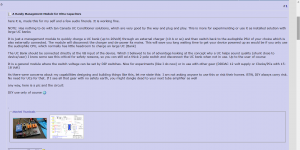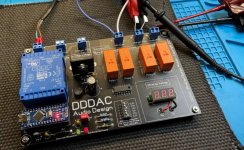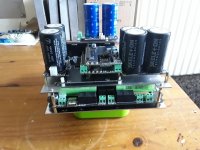Thank you Doede and eduard.
I have ordered a box of bc5xx transistors and will see if that is enough to fix the psu. I have spare MBR20200CT's and TIP122's available.
To clarify... I use the 12.5V psu for a more or less standard 4-decker + Fifopi cleanside, so I guess maximum 1A consumption.
Eduards answer does raise a few new questions.
Do you think a 22000uF cap in C3 is too much. Would 10000uF be a better choice for my 4-decker?
Isn't the C1+R1 and C2,C3+R2 considered RC filters?
With the R2 replaced by a Choke and a serial resistor doesn't we now have a LCRC filter?
...if not could you please give some more information about precisely how you would suggest a LCRC filter implemented in a DDDac PSU.
I'm sure other people would like to see more radical PSU-tweaks but needs more details.
Thank you 🙂
I have ordered a box of bc5xx transistors and will see if that is enough to fix the psu. I have spare MBR20200CT's and TIP122's available.
To clarify... I use the 12.5V psu for a more or less standard 4-decker + Fifopi cleanside, so I guess maximum 1A consumption.
Eduards answer does raise a few new questions.
Do you think a 22000uF cap in C3 is too much. Would 10000uF be a better choice for my 4-decker?
Isn't the C1+R1 and C2,C3+R2 considered RC filters?
With the R2 replaced by a Choke and a serial resistor doesn't we now have a LCRC filter?
...if not could you please give some more information about precisely how you would suggest a LCRC filter implemented in a DDDac PSU.
I'm sure other people would like to see more radical PSU-tweaks but needs more details.
Thank you 🙂
Take a look at the PSU schematic here.
The original filter is a CRC (C1 -> R2 -> C3). This is modified to a CLC by replacing the resistor by a chooke (or CRLC if you consider the DC resistance of the choke).
Take a look at my earlier post to learn about how to size the L and C parts properly.
The original filter is a CRC (C1 -> R2 -> C3). This is modified to a CLC by replacing the resistor by a chooke (or CRLC if you consider the DC resistance of the choke).
Take a look at my earlier post to learn about how to size the L and C parts properly.
Hello Denmark,
The R1 in the original circuit does limit the charging current a little bit. And people like Jean Hiraga sometimes use a little resistor at this spot to reduce '' noise '' caused by the switching of the rectifier if i am right.
The original circuit uses two RC filters.
Doede wrote in his blog that changing the second filter from RC into LC gave 15 DB extra ripple rejection.
Doede added a resistor in series with the choke probably to get the right amount of voltage drop. My idea would be that if you needed extra DCR why not use a choke with more mH= more wire= more DCR
Of course if you wanna keep using the same power transformer you will have to find out the maximum DCR for the choke so you will have enough voltage left for the circuit to work properly.
And you will have to check if you have the space available to put a choke.
During the last few years Doede did run a simulation on several of my LCLC supplies and all turn out good!
4700 cap, an LL1694 or LL2733 choke and a 10000 or 15000 final cap always worked for my 4 deck DDDAC.
A choke input power supply is a different animal and you will surely need another power transformer BUT you can surely use the LL2733 from Lundahl.
I prefer choke input EVERY time but you can start with CLC and if you like it you can take one step extra.
Greetings, Eduard
The R1 in the original circuit does limit the charging current a little bit. And people like Jean Hiraga sometimes use a little resistor at this spot to reduce '' noise '' caused by the switching of the rectifier if i am right.
The original circuit uses two RC filters.
Doede wrote in his blog that changing the second filter from RC into LC gave 15 DB extra ripple rejection.
Doede added a resistor in series with the choke probably to get the right amount of voltage drop. My idea would be that if you needed extra DCR why not use a choke with more mH= more wire= more DCR
Of course if you wanna keep using the same power transformer you will have to find out the maximum DCR for the choke so you will have enough voltage left for the circuit to work properly.
And you will have to check if you have the space available to put a choke.
During the last few years Doede did run a simulation on several of my LCLC supplies and all turn out good!
4700 cap, an LL1694 or LL2733 choke and a 10000 or 15000 final cap always worked for my 4 deck DDDAC.
A choke input power supply is a different animal and you will surely need another power transformer BUT you can surely use the LL2733 from Lundahl.
I prefer choke input EVERY time but you can start with CLC and if you like it you can take one step extra.
Greetings, Eduard
Has anyone built a dddac using the Salas SSLV 1.3 to power the main board and dac board? If so what values for the main resistor and large capacitor did you use?
Hello Denmark,
What you could also do is try the circuit designed and described by Doede a few months ago in the power supply section here.
I will use it for the Italian external clock circuits in the near future.
It will surely take more space than adding a Lundahl LL2733 choke. Also will take more money. Plus on top of that more time. I think if the space is there properly installing the LL2733 will take 2 hours maximum.
Using the LL2733 in a choke input configuration will require another power transformer ( to be mounted on the chassis i guess together with the rectifier) So that will take a few hours.
Greetings, eduard
What you could also do is try the circuit designed and described by Doede a few months ago in the power supply section here.
I will use it for the Italian external clock circuits in the near future.
It will surely take more space than adding a Lundahl LL2733 choke. Also will take more money. Plus on top of that more time. I think if the space is there properly installing the LL2733 will take 2 hours maximum.
Using the LL2733 in a choke input configuration will require another power transformer ( to be mounted on the chassis i guess together with the rectifier) So that will take a few hours.
Greetings, eduard
Attachments
@eduard
Thank you very much for your suggestions. I might very well expand on the Choke or Super Cap upgrades later, when I successfully have implemented the DDDac PSU LCRC tweak without exploding anything.
NB!!! I did in my secondary DDDac 🙂
@mbrennwa
Thank you too. I did read your #8386 post... In fact many times ;-) Still struggling a bit with the L < DCR² x C / 4 formula but one day I might get it ;-)
Anyway, you already did answer the question regard the C3 value in Post #8556
Thank you very much for your suggestions. I might very well expand on the Choke or Super Cap upgrades later, when I successfully have implemented the DDDac PSU LCRC tweak without exploding anything.
NB!!! I did in my secondary DDDac 🙂
@mbrennwa
Thank you too. I did read your #8386 post... In fact many times ;-) Still struggling a bit with the L < DCR² x C / 4 formula but one day I might get it ;-)
Anyway, you already did answer the question regard the C3 value in Post #8556
Still struggling a bit with the L < DCR² x C / 4 formula but one day I might get it ;-)
What's the problem? Let me know how I can help.
Hello.
I have built several supplies which needed to supply to 1 to 1,5 A in LCRC and LCLC configuration using only PSUD software and also had a few of them '' checked '' by Doede who uses a more sophisticated program and there has never been any issue. Maybe because chokes or usually low inductance because of high current.
Greetings, Eduard
I have built several supplies which needed to supply to 1 to 1,5 A in LCRC and LCLC configuration using only PSUD software and also had a few of them '' checked '' by Doede who uses a more sophisticated program and there has never been any issue. Maybe because chokes or usually low inductance because of high current.
Greetings, Eduard
Hi Everyone. Those DDDAC users who are using the FifoPi, is there anyone who has already integrated the ReclockPi with the FifoPi and Accusilicon 318 clocks? If yes, did you notice any improvements? Are the changes significant enough to definitely add the ReclockPi on top of a FifoPi? I have read Ian's thread and his responses to Doede and there was certainly reduction in MCLK and SCK/BCK jitter levels. Now data is one thing and hearing improvements, if any, is another. Hence, I thought it best to ask our group here about their experience. I have just taken the plunge and have ordered the ReclockPi. What gave me confidence were the recommendations serious DDDAC builders gave to DD on his blog, in the comments section.
Looking forward to your responses here.... Ciao.
Looking forward to your responses here.... Ciao.
Hello,
I have a pile of boards waiting to be installed in my DDDAC chassis but waiting for the Sinepi and a clear tutorial how to get the best results with Fifo combined with the DDDAC.
Now the information is to widely spread and there is nothing like the original DDDAC in terms of intelligibility written for the Fifo.
Greetings, Eduard
P.s by the way getting your ears cleaned in a Vietnamese barbershop will let you hear more details for the price of a good cup of coffee in the western world
I have a pile of boards waiting to be installed in my DDDAC chassis but waiting for the Sinepi and a clear tutorial how to get the best results with Fifo combined with the DDDAC.
Now the information is to widely spread and there is nothing like the original DDDAC in terms of intelligibility written for the Fifo.
Greetings, Eduard
P.s by the way getting your ears cleaned in a Vietnamese barbershop will let you hear more details for the price of a good cup of coffee in the western world
Attachments
Hello,
Maybe i found someone who write a manual for Fifo tower and my DDDAC in exchange for my old Aurender which will otherwise end up in the attic/garbage truck after installing the Roon nucleus clone someone build for me with a pimped power supply by Doede.
Greetings, eduard
Maybe i found someone who write a manual for Fifo tower and my DDDAC in exchange for my old Aurender which will otherwise end up in the attic/garbage truck after installing the Roon nucleus clone someone build for me with a pimped power supply by Doede.
Greetings, eduard
Stick the FiFo on the RPi. Done. (Really, that's pretty much everything!)
Please send the Aurdender, thanks! 😀
Please send the Aurdender, thanks! 😀
Hello,
I have done most of the metal work '' design '' myself which was pretty easy.
It is more connecting all the power and signal wiring correctly that is the problem.
I will wait for the manual to arrive within a few days i hope.
Greetings, Eduard
I have done most of the metal work '' design '' myself which was pretty easy.
It is more connecting all the power and signal wiring correctly that is the problem.
I will wait for the manual to arrive within a few days i hope.
Greetings, Eduard
Quick update, got the Reclockpi which has been put on the FifoPi with Accusilicon 318 clocks. Must say a wonderful add on. Major changes noticed: stage depth added, a lot of air around instruments, much cleaner transients, bass bloat has reduced tremendously and i sense tighter bass!
Detailed feedback will be shared in a few weeks!
A very useful add on. Highly recommended!!
Detailed feedback will be shared in a few weeks!
A very useful add on. Highly recommended!!
I just posted part 5 of the clock reviews.
This time with the Neutron Star 3 versus the TWTMC from Andrea Mori.
enjoy the read:
DDDAC Blog: the clock reviews part 5/
.
This time with the Neutron Star 3 versus the TWTMC from Andrea Mori.
enjoy the read:
DDDAC Blog: the clock reviews part 5/
.
Attachments
I just posted part 5 of the clock reviews.
This time with the Neutron Star 3 versus the TWTMC from Andrea Mori.
enjoy the read:
DDDAC Blog: the clock reviews part 5/
.
Nice comparison Doede. Refreshing to see your grounded, non-superlative
loaded evaluation.
I am interested to see what sort of measured phase noise spec the NS3 clock
achieves. Parts connexion have these for $500us incl power supply which is
far from cheap but at the same time not crazy money.... 🙂
What did the total cost of Andrea's clock + PS + doubler + squarer etc end
up at?
TCD
Hello,
I am going to use the " Italian solution " as well have 95 % of the part just waiting for the Sinepi to arrive.
If you also add the extra chassis ( that you will need probably), sma terminated cables, Ucpure supply with 6 supercaps( or the Eaton solution Doede and I are using), 6 boxes for the 6 circuit boards and some other cheaper parts you will end up with something 4 times as expensive if not more.
Of course if you dont try the Italian way the 500 $ is a lot cheaper AND easier.
IF i wouldnt have invest a lot of money i would probably go for the cheaper one and maybe give the Ucpure a try with it.
Greetings,Eduard
I am going to use the " Italian solution " as well have 95 % of the part just waiting for the Sinepi to arrive.
If you also add the extra chassis ( that you will need probably), sma terminated cables, Ucpure supply with 6 supercaps( or the Eaton solution Doede and I are using), 6 boxes for the 6 circuit boards and some other cheaper parts you will end up with something 4 times as expensive if not more.
Of course if you dont try the Italian way the 500 $ is a lot cheaper AND easier.
IF i wouldnt have invest a lot of money i would probably go for the cheaper one and maybe give the Ucpure a try with it.
Greetings,Eduard
- Home
- Source & Line
- Digital Line Level
- A NOS 192/24 DAC with the PCM1794 (and WaveIO USB input)



